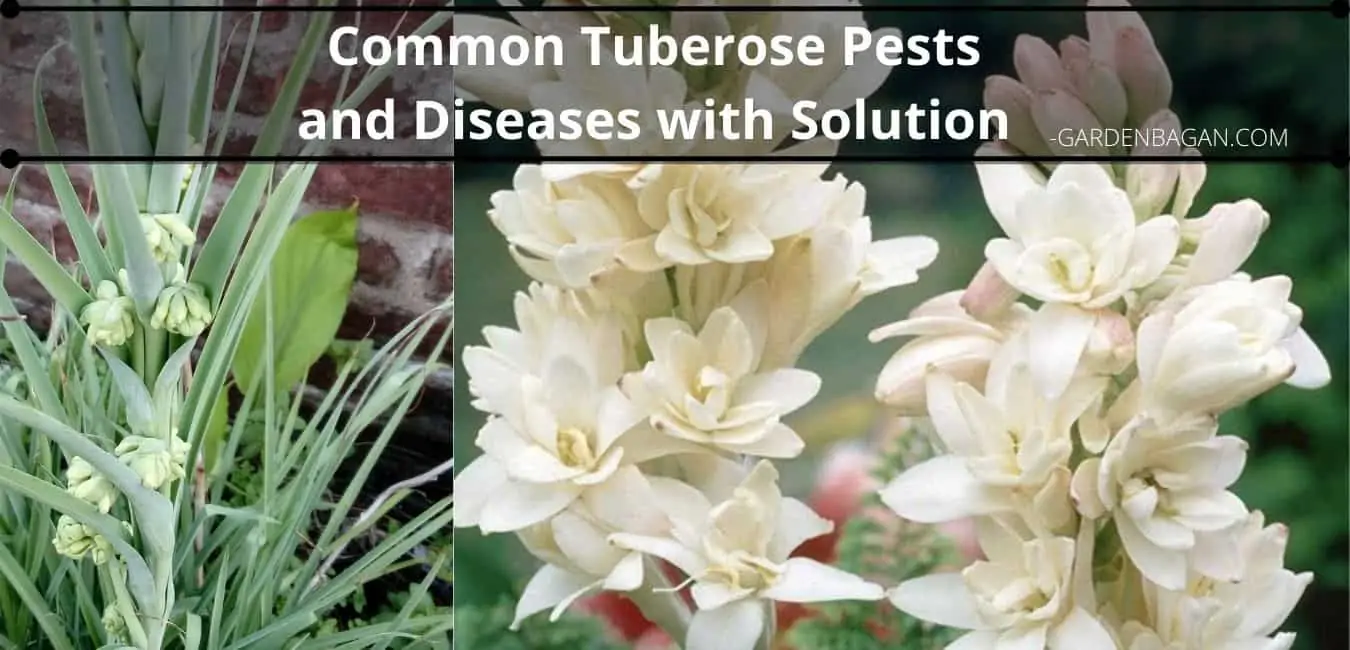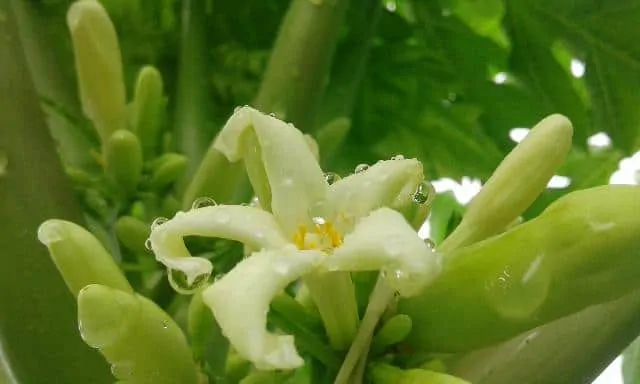Welcome back, friends. Guys if you like Tuberose and want to grow one in your garden. Then you should learn about common tuberose pests and diseases. This will help you to keep the plant healthy for many years. Therefore, I have created this short easy to understand article for your help.
Tuberose is a Perineal flowering plant. Its flowers have intense fragrance. Tuberose is an evening-night bloomer flower. This means the flowers start to bloom in the evening and continues throughout the night. Early morning is the best time to smell the strong sweet smell of tuberose.
Tuberose is a hardy plant and can survive low moisture conditions. It is not very prone to pests and disease attacks. Still, tuberose can face some pests and diseases especially during high moisture or rainy days.

Check out: How to Grow Tuberose- Polianthes Tuberosa, Rajanigandha?
Animals Causing problem to Tuberose
Generally, no herbivore likes to eat a Tuberose plant. I think the leaves are not so tasty. Still, My plants are hurt by a couple of squirrels.
Squirrels don’t eat the plant instead they cut the tip of buds. Sometimes they Cut the entire tuberose flower spike before maturing.
A tuberose plant takes almost 120 days to form a flower spike. It is really heartbreaking to see it damaged before flowering. But this is not a very common problem. At least not for every Tuberose gardener.
Sometimes Rodents can also damage the tuberose plants. Rats and Moles can dig the tuberose bulbs and damage them. This problem is common with open fields and gardens.
They can also cut the leaves and flower spikes. You have to be active to control rodents in the garden.
Solution
Simply Move the Tuberose plant away from the wall. I noticed that the wall helps the squirrels to reach the buds. They usually don’t cut the plant at the base.
An alternate option to try is to feed the squirrels enough. So that they don’t attract towards you tuberose. let me know if you have a better idea.
You can also use Mouse traps to control rodents in the garden. Using chemicals especially to kill Rodents is not recommended. This is obviously the last option to choose.
Do you Know?- Is Tuberose Annual or Perennial?-Rajanigandha
Common Pest of Tuberose
Ideally, tuberose is free from any insect or pests attack. But sometimes you may have to face them. So let us see the insects and pests that can harm a tuberose plant.
- Snails
- Grasshoppers
- Aphids
- Red Spider mites
- Thrips
- Bud borer
- Weevils
- Nematodes
Snails and Grasshoppers feed on soft young leaves and flower buds. Handpicking them at night can be effective. But This will not work for large flower gardens.
Solution for Snail and Grasshopper problem in Garden
- Use a net around the plants to prevent entry. If you stop them to enter then they can’t lay eggs on the plant or soil.
- You can spread ground eggshell and cornmeal around the plant to stop snails. Broken eggshells are like small knives to their soft body. therefore, it is a useful and organic way to control snails.
- You have to clean the tuberose buds and leaves to treat grasshoppers. They usually lay eggs under leaves and between soft flower buds. Spray oil and soap solution to kill the eggs.
- You can also use 5% Cythione or Folidol to dust off the eggs and small grasshoppers. Spraying 0.05% Quinalphos i.e. 0.5ml/L of water or Malathion 0.1% or Carbaryl 0.2% solution to the new plant foliage can help controlling Grasshopper attacks.
Aphids

Aphids are small soft-bodied insects. They feed on plant sap and targets soft leaves and flower buds. Usually aphids attacks in groups. They can have transparent green, black, brown, or purple color.
Few of these tiny insects are no problem but their whole colony can damage the plant.
Solution
- Spray the infested plants regularly with 1-2% soap and neem oil solution. This will kill the aphids and prevent any serious attack.
- If the situation is worse then use Malathion 0.1% or Rogor solution once every 15 days.
Red Spider Mites
Spider mites are another harmful pest that can attack your tuberose plant. They feed on the soft stem, leaves, and flower buds. The infected plant can wilt and the buds can deform. Yellow fibrous lines are clearly visible on the plants infected with red spider mites. These are the trails on which they suck the plant sap.
Solution
- Move the infected plant aways from others at the initial stage. Remove its infected leaves and burn them. It is very easy to control spider mites at the initial stages.
- If the situation is worse the use Kelthane 1.2% solution with water to treat the mites. you may have to repeat the application several times.
Weevils (Myllocerus sp)
You can easily identify a tuberose plant infected with Weevils. They feed on the leaf edge and leave a curve notch. Weevils usually attack leaves and soft shoots. Their larvae feed on roots and flower buds. they dig tunnels to reach the soft juicy core.
Vigorous attacks of weevils can be disastrous to the tuberose garden.
Solution
- Treat the soil before plantation with BHC 10% concentration. It will control the larvae and prevent weevil attacks.
Nematodes
nematodes are microscopic worms living in the soil. Most of the time they are not harmful to the plants. But some variants of nematodes can damage the tuberose crop. they usually damage the root structure from inside. It can cause stunted growth in the plant. The infected plants can be easily identified among others. They appear sick and eventually die due to root rot.
Some of these harmful nematodes are-
- Two root- Knot Nematode (Meloidogyne incognita and Meloidogyne javanica)
- Reniform nematode (Ro-tylenchulus reniformis)
- Greasy streak nematode (Aphelencoides bes-Seyi)
Solution
- Application of Thimate or Furadan in the soil before sowing the bulbs can be helpful. You can use Furadon or Carbofuran (2 gram per plant).
Bud Borer
These tiny insects lay eggs on the flower spikes. The larvae come out and dig deep into soft buds. Then they feed on the soft core of the stem and flower buds. You can seed small holes on the buds and flower stem of an infected tuberose plant. The bud borer does not harm the plant itself instead damages the flower crop. It can cause heavy economical loss to the cultivators.

Solution
- Pick the damaged flower and destroy them. This can prevent further infestation of Bud borers in healthy tuberose plants.
- Set light traps to attract and lure these bugs away from the tuberose flowers. This is an effective and organic method to control the population of Bud Borers.
- Neem Oil spray is very effective in repelling Bud Borer insects. Use it in 1% concentration with water twice every week.
- In case of severe attack spray monocrotophos at 0.2% concentration or Thiodon (0.5%-0.8%). Methyl Parathion at 0.05% concentration can help in controlling the eggs over buds and soft foliage.
Tuberose pests and diseases are mostly caused by unfavorable environmental factors like rain or wind. Heavy rain or overwatering can deposit moisture on the foliage and attracts aphids and other pests. Therefore, Avoid watering over the leaves, try to keep the foliage dry.
Common Diseases of Tuberose
There is 5 major disease that can cause problems in Tuberose cultivation. They are-
- Stem Rot due to Sclerotium rolfsii fungus
- Flower Bud Rot caused by Erwinia sp.
- Leaf Blight or Botrytis blight due to Botrytis elliptica fungus
- Sclerotial Wilt caused by Sclerotium rolfsii fungus
- Alternaria leaf spot caused by Alternaria polyantha fungus
Stem Rot and Sclerotial Wilt
Stem rot and Sclerotial wilt is caused by Sclerotium rolfsii fungus. You may observe coarse, mycelial covering on the leaf surface before infestation. It is followed by light green patch formation due to rotting. Finally, dark brow patches form on the leaf surface and it will fall off.
The wilting starts with the yellowing of leaves which will dry eventually. The infection spreads upwards from the root.
Solution
- Use Zineb 0.3% for wilt disease and 20% concentration for Stem rot disease. 1% solution of Brassicol is also effective in controlling stem rot disease.
- You can avoid these problems by Controlled watering and proper space management.
Flower Bud Rot
Flower bud rot in tuberose is caused by Erwinia sp. The buds will dry rot and the flower spike will not develop completely.
Solution
- The easiest solution to this problem is to uproot the infected plant and destroy it.
- You also spray 0.01% solution of streptomycin to control the bud rot disease.
Botrytis Blight or Leaf Blight
The leaf blight disease is caused by Botrytis elliptical fungus. This problem is common during the rainy season. The disease starts with dark brown patches on flowers. It is followed by leaves and the stem. Finally, the whole flower spike will dry.
Solution
- Spray Carbendazim as a solution of 2gram per liter once every 15 days. the use of 2% ammoniacal copper or 0.5% Greeno can also control this disease. It should be repeated at a 15-day interval.
Alternaria Leaf Spot
The Alternaria Leaf Spot disease is caused by Alternaria polyantha fungus. You can observe brown spots with concentric rings on the mid-rim of the leaf blade. Initial infection is not very harmful but it can spread quickly to destroy the foliage of the tuberose plants.
Solution
- You can use Bordeoux mixture (0.4%) Zineb(0.5%), Mancozeb(0.2%), or Iprodione (0.2) at 10 day interval to colntrol the leaf spot disease.
Also, read Why is my Butterfly Pea plant not flowering?-Clitoria Ternatea
Final Word
Sometimes Rusting and Powdery mildew can also affect the tuberose plants. We can control them with any contact or systemic fungicide.
Do you know some other tuberose pests and diseases? If yes Then Please let us know. Your suggestions can help many flower gardeners.
Keep Reading keep gardening!
Reference: https://vikaspedia.in/agriculture/crop-production/package-of-practices/flowers/tuberose


Hi Sukant,
Thanks for the wonderful tips. My tuberoses (Have only 2) have been infeste with very tiny black insects that are feeding on the flowers. Please help.